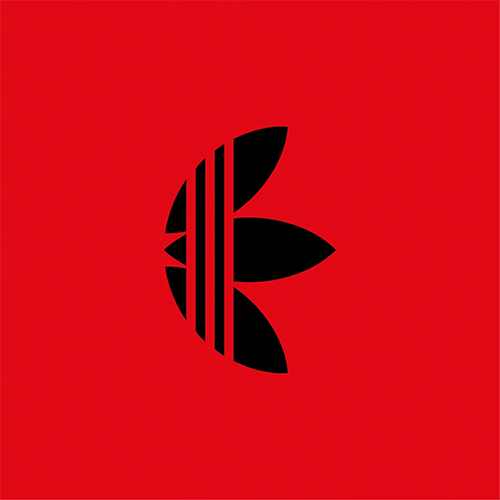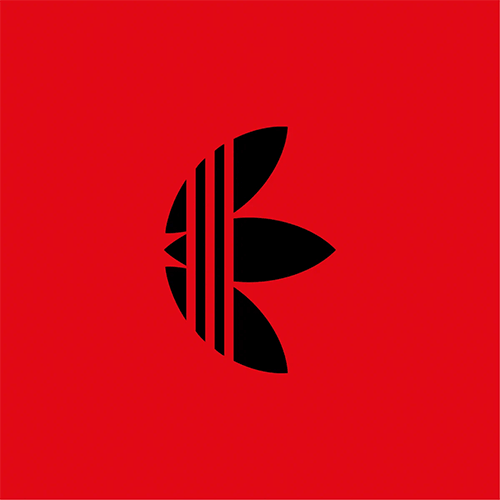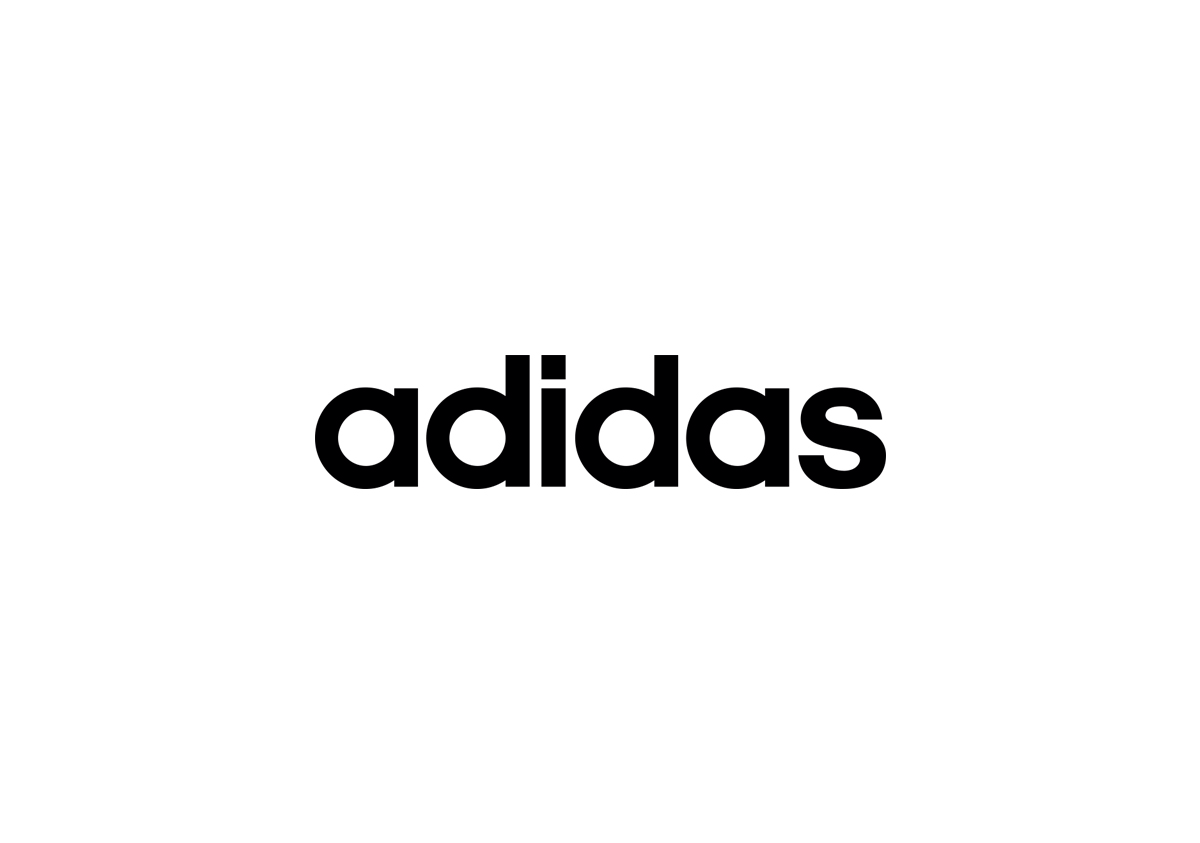As adidas Pushes The Limits of NFT-Based Customer Engagement, It Encounters the Perils Too
There are very few global brands that are pushing NFT technologies to the brink of their capabilities the way adidas is with its ALTs customer engagement and loyalty program. Watching the company execute has been like getting a masterclass on how to succeed with NFTs. But, in the sports fashion giant’s most recent drop, we learn about the perils too.
Published: November 2, 2023

11 min read


Editor’s Note: In an effort to provide our audience with fair and fact-checked journalism, Blockchain Journal contacted adidas to verify some of the findings in this article and to give adidas an opportunity to comment. Adidas acknowledged our overture but declined to comment or inquire about our findings.
History seems determined to repeat itself. Over the last decade, more and more established consumer goods companies are working to morph themselves into tech platforms. And often, they are encountering the same rocky roads and failures that many well-established tech companies have learned (sometimes the hard way) to avoid, especially when fresh, relatively untested (and therefore risky) technology is involved. As evidenced by a recent NFT drop by adidas in collaboration with luxury brand Moncler, even the most visibly advanced and successful of the many NFT-involved brands in the world can be prone to failure, friction, and ultimately, customer disappointment. As examples go, this real-world anatomy of a troubled NFT drop is a teachable moment about life on blockchain’s bleeding edge.
According to Blockchain Journal’s research, many of the enterprises that are experimenting with distributed ledger technologies, such as public blockchains, are starting with NFT-based customer engagement and loyalty programs more often than for any other blockchain use case. As use cases go, acceptance of cryptocurrency as a form of payment is a distant second place. Although some NFT-based customer engagement and loyalty programs are in their infancy, by most measures, the adidas ALTs project could be the most sophisticated, mature, and successful of the NFT programs currently in play by a well-recognized global consumer brand.
But as mature as that program is, adidas may have also set itself up for the problems encountered by customers during an October 5, 2023 drop involving a collaboration between the adidas Originals brand and Moncler (Moncler is one of multiple Moncler Group fashion brands whose 70-year-old roots are traceable to the mountainous area of Monestier-de-Clermont where some of France's earliest ski areas were founded). The first of these challenges — a version of friction that Blockchain Journal has observed across NFT programs from other global brands — is the division of the end-to-end customer experience across multiple websites, platforms, and applications.
For example, like many other NFT-involved consumer brands from Starbucks to Hyundai, adidas uses the Discord community platform as a proverbial town square for its ALTs NFT program. Among other things, the adidas ALTs Discord server is where members of adidas’ Web3 team — Three Stripes Studio — engage directly with ALTs program participants, keeping them abreast of upcoming drops and other program activities.
But as demonstrated in the partial screenshots below, instead of relying on Discord (where most if not all of the program’s participants are already “gathered”) to explain exactly how to get involved in the Moncler x adidas Originals drop, adidas forced users to switch away from Discord to a thread it published on X (formerly Twitter) for instructions on what to do.
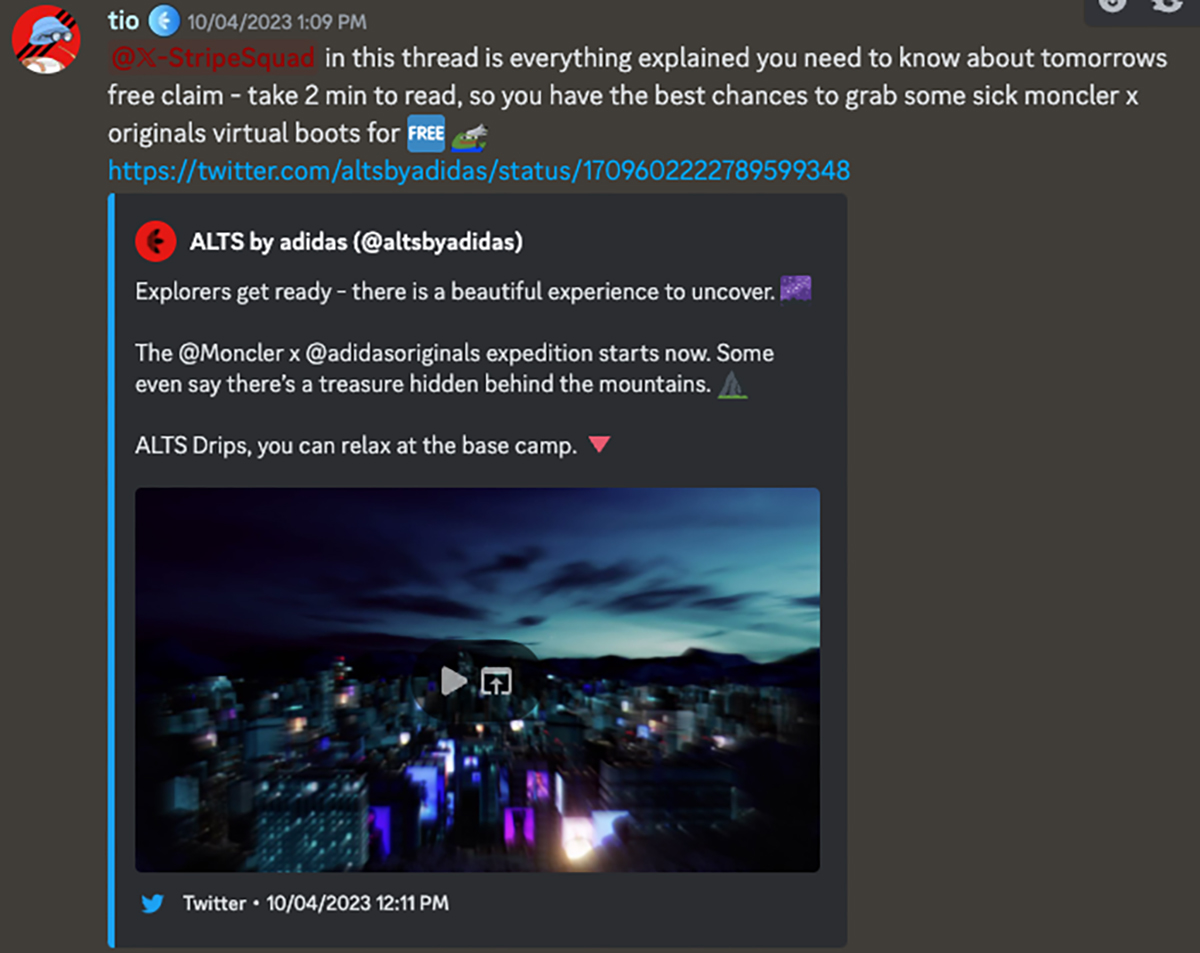

On October 4, 2023, adidas instructed ALTs NFT program participants to click over to X (formerly Twitter) to find the specific instructions on how to get involved in the next day’s free but limited quantity (3,000) drop.
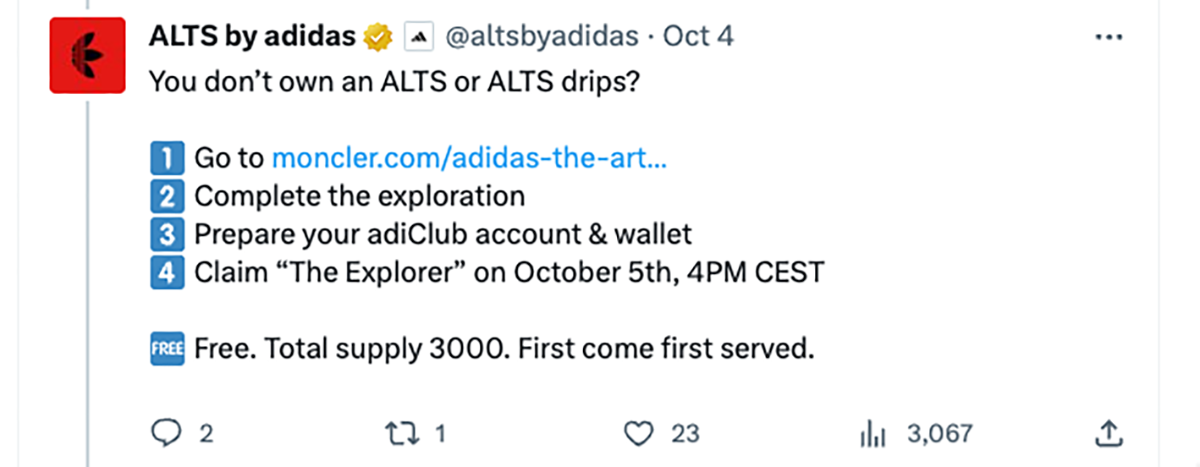

Instead of publishing drop participation details on its Discord server where most ALTs users were already gathered, adidas sent users over to X (formerly Twitter) to get the instructions.
As can be seen from the partial screenshot above, adidas published a sparse set of instructions to its X account when it could have just as easily published those same instructions to its Discord server. As choices go, X is hardly viewed as a platform for publishing user documentation. Even more baffling was the prompt for users to publish any questions they might have to X instead of using Discord, which is much more well-equipped than X to provide (and organize) detailed technical support posts (see partial screenshot below).
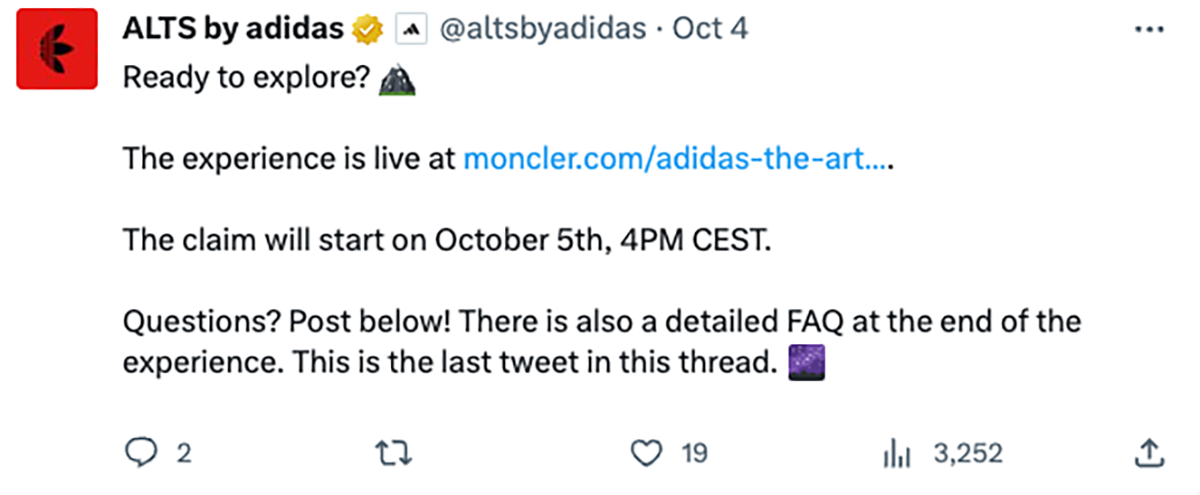

Users of the ALTs program were prompted by adidas to post any questions they have about the Moncler x adidas Originals drop to X instead of to the adidas Discord server (a platform that compared to X, is much better equipped to deal with the threading and management of such questions).
As seen in the screenshot above, there were minimally four non-seamless steps for end users to negotiate. In reality, however, not only were those four steps poorly documented (again, in our opinion, X is not a good platform for user-friendly technical documentation), but there were other steps that should have been comprehensively documented via a single source of truth (a document or video) using a clearly enumerated process complemented by copious screen captures.
For example, the first step required the user to visit and explore an animated catalog of fashion offerings on Moncler’s website. This was simple enough and that exploration ended with a call-to-action to “Claim Your NFT.”
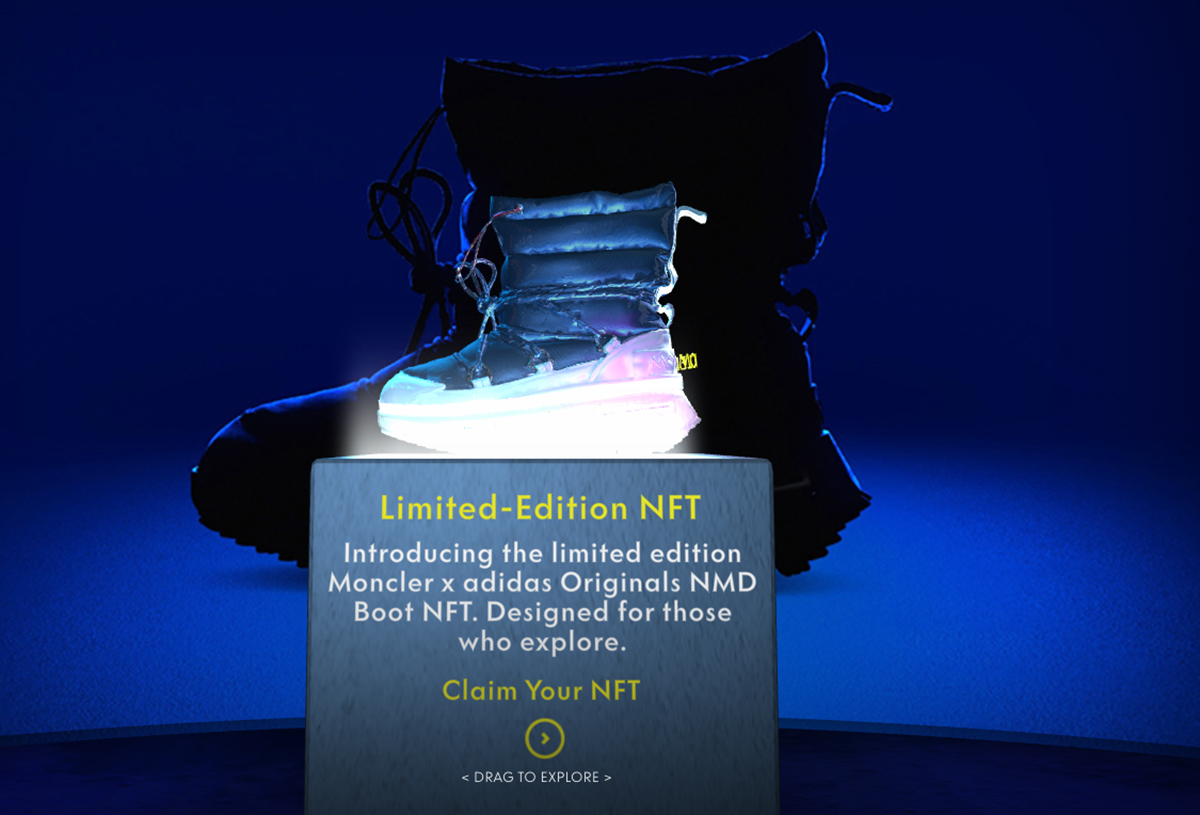

After exploring an animated and interactive catalog that features various fashion offerings from the Moncler x adidas Originals collaboration, users were presented with an offer to claim their NFT.
Clicking the “Claim Your NFT” button then transported the end user to a different web page hosted on a subdomain that is the home domain of the adidas ALTs NFT program (https://collect.adidas.com).
For many users, the first opportunity for confusion probably arose out of this transition from the Moncler website to the adidas website. As customers picked up their user experience on the adidas website, they encountered a looping animation that was nearly identical to the animation they initially encountered when beginning the journey on the Moncler website. It was almost as though the entire user experience had been restarted from the beginning (a misunderstanding that was promulgated by the prompt to “SCROLL TO EXPLORE”; something the end user just finished doing). Initially, there was no obvious call to action to continue the process of “Claiming your NFT.”
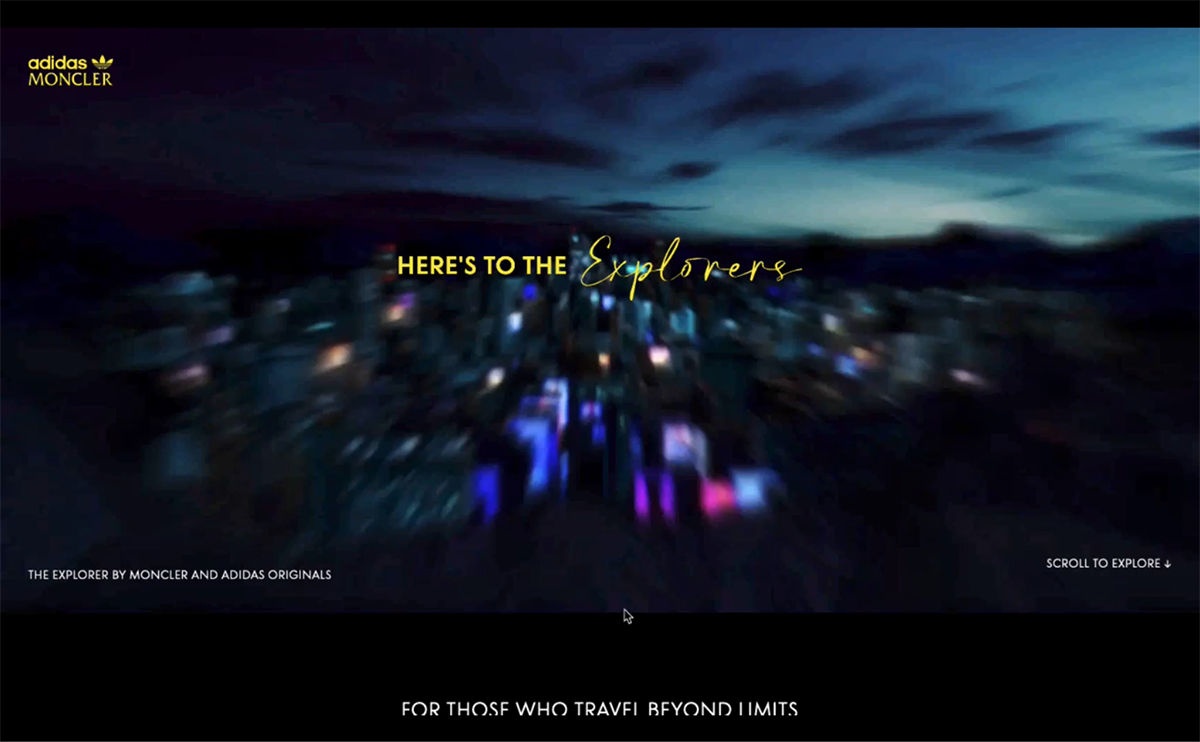

After the user clicks “Claim your NFT,” the user experience automatically shifts from Moncler’s website to the web subdomain used by the adidas ALTs NFT program. But there wasn’t a clear call-to-action for the end user to continue the process of claiming their NFT.
Eventually, as shown in the screenshot below, adidas updated the landing page on its website to incorporate the missing call-to-action. However, with only limited subsets of the 3,000 total NFTs available to different global geographies, the fix came after some users — in their race against time and other users competing for those limited quantities — worried that the clock had run out.


At some point, after the competition for the limited number of Moncler x adidas Originals NFTs started, the adidas-hosted landing page appeared to have been updated with a “CLAIM NOW” button. The addition of the button made for better user experience continuity in the handoff between the Moncler-hosted part of the process and the adidas-hosted part. The yellow arrow is a Blockchain Journal annotation to the screenshot.
As it turned out, users only needed to scroll further down on the adidas-hosted page to reveal the “claim” portion of the page. The miscue could have been avoided by changing the text in the lower right-hand corner from “SCROLL TO EXPLORE” to “SCROLL TO CLAIM.” The problem with “SCROLL TO EXPLORE” is that the user just finished “scrolling to explore” on the Moncler portion of the end-to-end experience. Seeing the invitation to “SCROLL TO EXPLORE” appeared as a redundant call-to-action to restart the already-completed exploration. As steps in the process went, there was no more exploration to do.
But the confusing burdens on the customer did not end there. Going back to the third of the four-step process that adidas published to X, the specifics on how to “[prepare] your adiClub account & wallet” were sprinkled elsewhere (at this point, we desperately just wanted to RTFM, but there was no M to read). Another tweet from the ALTs by adidas X account offered a confusing clue.
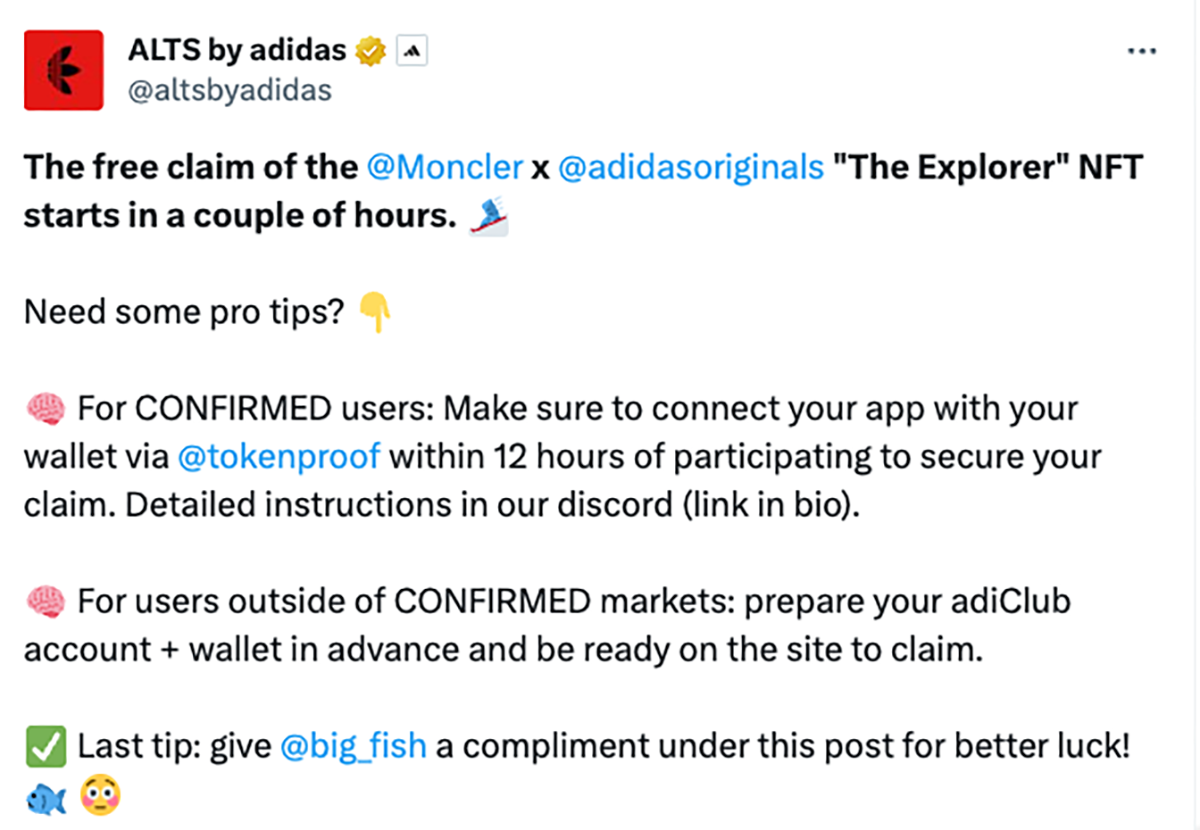

The so-called pro tips were definitely for professional devotees of the adidas brand who, from prior experience, would have known that the word “CONFIRMED” is the name of a mobile app published by adidas.)
For those who are not 100 percent familiar with the adidas technology portfolio, adidas has developed a mobile application called the CONFIRMED app. The app pre-dates any adidas NFT programs and, among other uses, it is where devotees of the adidas brand can learn about and participate in the hottest upcoming drops of physical merchandise (e.g., limited production sneakers). The app is adidas’ competitive equivalent to Nike’s SNKRS app.
But for some people who are unfamiliar with the existence of the CONFIRMED app and who saw the above tweet as a clue to make it to the finish line to claim one of the 3,000 Moncler x adidas Originals NFTs, the statement “For CONFIRMED users” was a source of additional confusion that naturally led to an important, literal, but ultimately irrelevant question: How do I know if I’m a confirmed or unconfirmed user? The tweet goes on to say “Make sure to connect your app with your wallet via @tokenproof within 12 hours of participating to secure your claim.” For users who didn’t realize that “CONFIRMED” is the actual name of the adidas mobile app, this statement almost comically leads to the next obvious question: What app?
As we at Blockchain Journal went through the user experience ourselves, it wasn’t until we went back to the aforementioned adidas-hosted page, accidentally scrolled down, and found some additional clues that caused us to realized that the word “confirmed” was possibly referring to an app and not the past tense of the verb “confirm.”
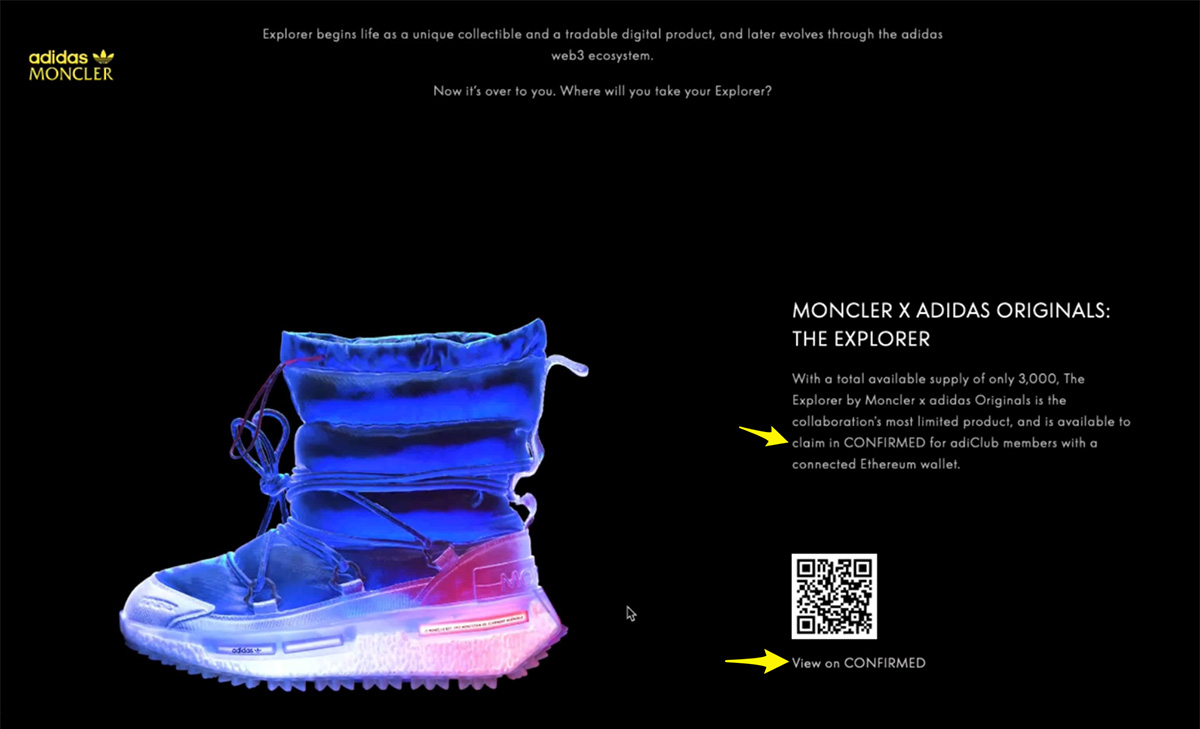

The adidas-hosted page for claiming one of 3,000 Moncler x adidas NFTs contained hints that the word “CONFIRMED” was the name of an app.
Not to intend a pun, but our instincts were confirmed when, because of the four-step set of instructions that were originally tweeted by the adidas ALTs team, we also Googled “adiClub” to “prepare our adiClub account” (one of the official four steps). The adiClub home page mentions the CONFIRMED app by name, thus bringing closure to at least one mystery.
We took what felt like the next obvious step. We installed the CONFIRMED app on a smartphone and set up an adiClub account. But connecting the app to our wallet (as instructed) became such an exercise in futility that we nearly gave up on the entire idea of getting an NFT.
As hard as we looked, we could not find an obvious menu option to connect the app to our cryptocurrency wallet (which, in a completely separate and independent step, also had to be installed on the same smartphone). But then, a glimmer of hope; we discovered that the app included a chat-based technical support feature to get help. As the chat feature came to life, it told us that “Enrico is here to help you.”
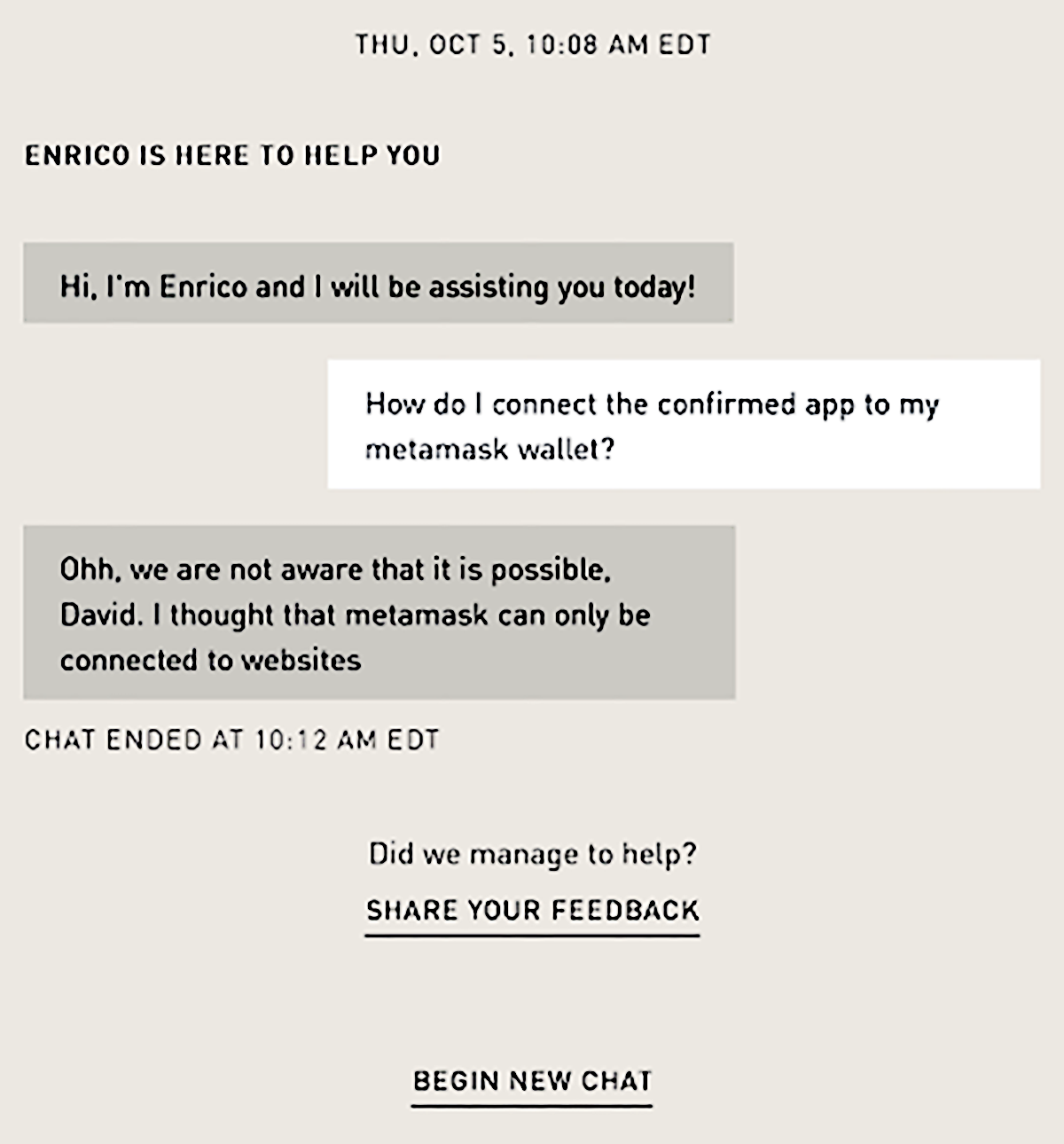

The adidas technical support team was of little help when it came time to connect the adidas CONFIRMED mobile app to a cryptocurrency wallet.
But as can be seen from the above screenshot, after asking Enrico how to connect the CONFIRMED app to a MetaMask wallet (and almost in spite of the directions tweeted from the ALTs by adidas X account), Enrico replied “We are not aware that it’s possible.” It’s the sort of customer experience that we’ve come to expect from the cable TV company. But not adidas.
At this point, it wasn’t clear what path to take. It was then, before finally giving up, that we noticed the QR code on the adidas-hosted landing page (see screenshot above). After scanning it using the smartphone and tapping on its link, the CONFIRMED app (which was already open on our smartphone) sprang to life only to reveal the following error.
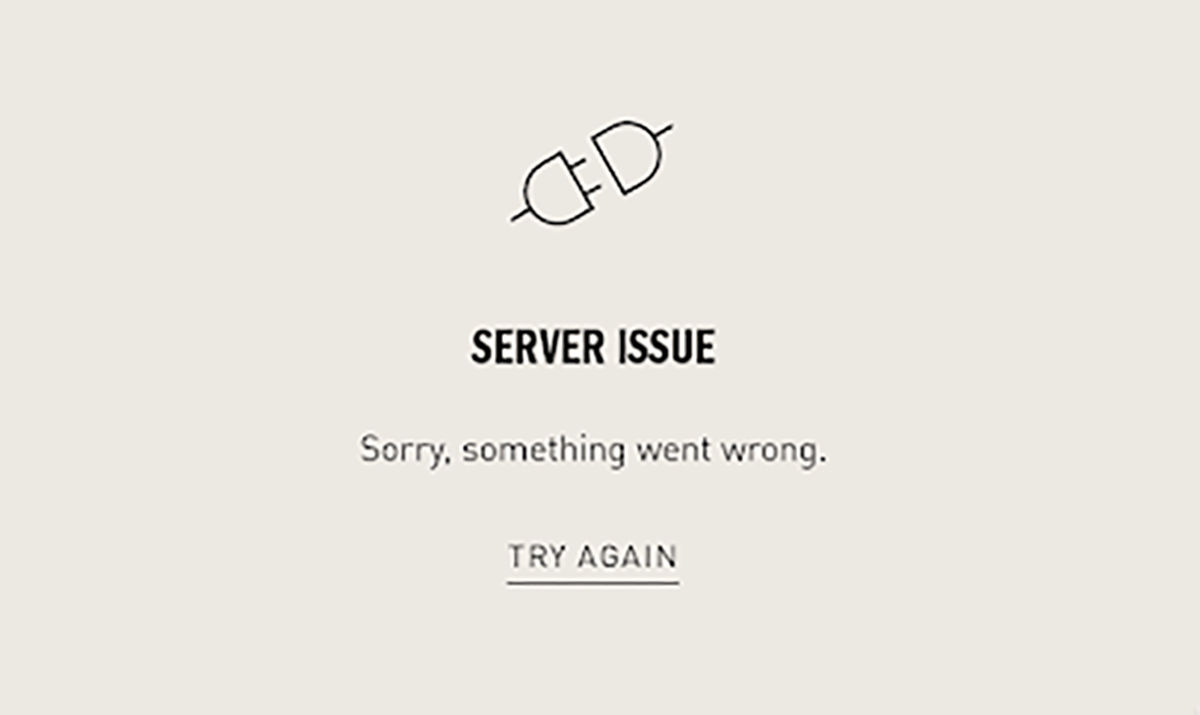

The adidas CONFIRMED app could not establish communication with whatever servers it was looking for across the internet.
Of course, we tapped the TRY AGAIN link about 1,000 times as we imagined other users beating us to what few NFTs remained out of the 3,000 that were originally available. But with every tap, we received the same error message. A visit to the adidas ALTs Discord server revealed that we were not alone in running into this and other obstacles. While plenty of users used Discord to share screenshots of their success at securing one of the 3,000 NFTs, other users also voiced their frustration.
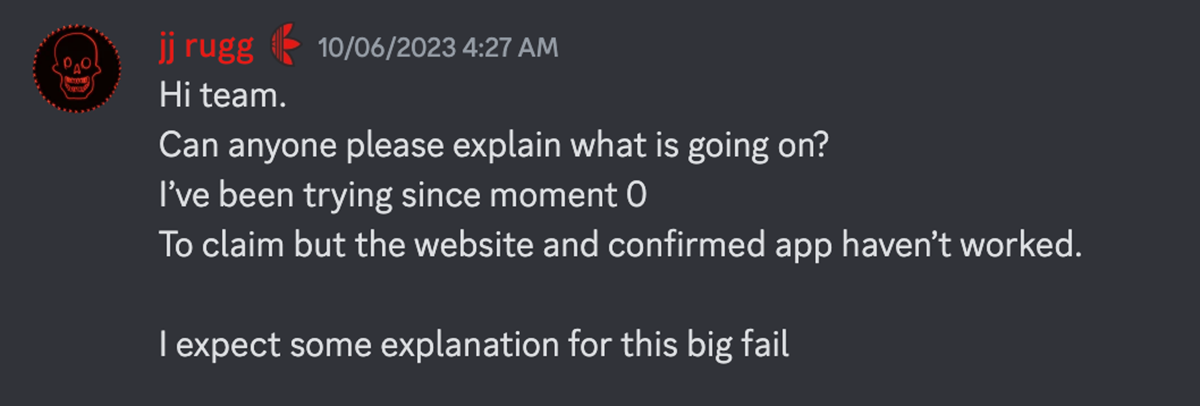

As the Moncler x adidas Originals drop unfolded, the adidas ALTs Discord server was flush with reports of frustrations and bugs.
But, for whatever reasons (divine providence?), the idea of trying to shut down the CONFIRMED app before trying again came to mind and voila; after scanning the QR code again, the CONFIRMED app launched into a workflow that not only automatically prompted us to connect our wallet, it also made it clear that we needed to also install yet another mobile app — the Tokenproof app — to complete the claim process. That’s three separate mobile applications that had to be installed in order to complete the customer experience: a cryptocurrency wallet, the CONFIRMED app, and Tokenproof. The CONFIRMED app relies on the Tokenproof app to interrogate the connected wallet in order to prove that the user of the CONFIRMED app is also a holder of an adidas ALTs NFT (in an act of what's known in the blockchain industry as token-gating, holding an ALTs NFT was a prerequisite to participating in the drop). Finally, after a long, arduous journey across multiple websites, applications, and platforms, we were awarded of one of the remaining NFTs (as shown in the screenshot below).


Of course, just when we thought it could not get any worse, the CONFIRMED app prompted us to connect our wallet, which as far as we knew, we had already done.
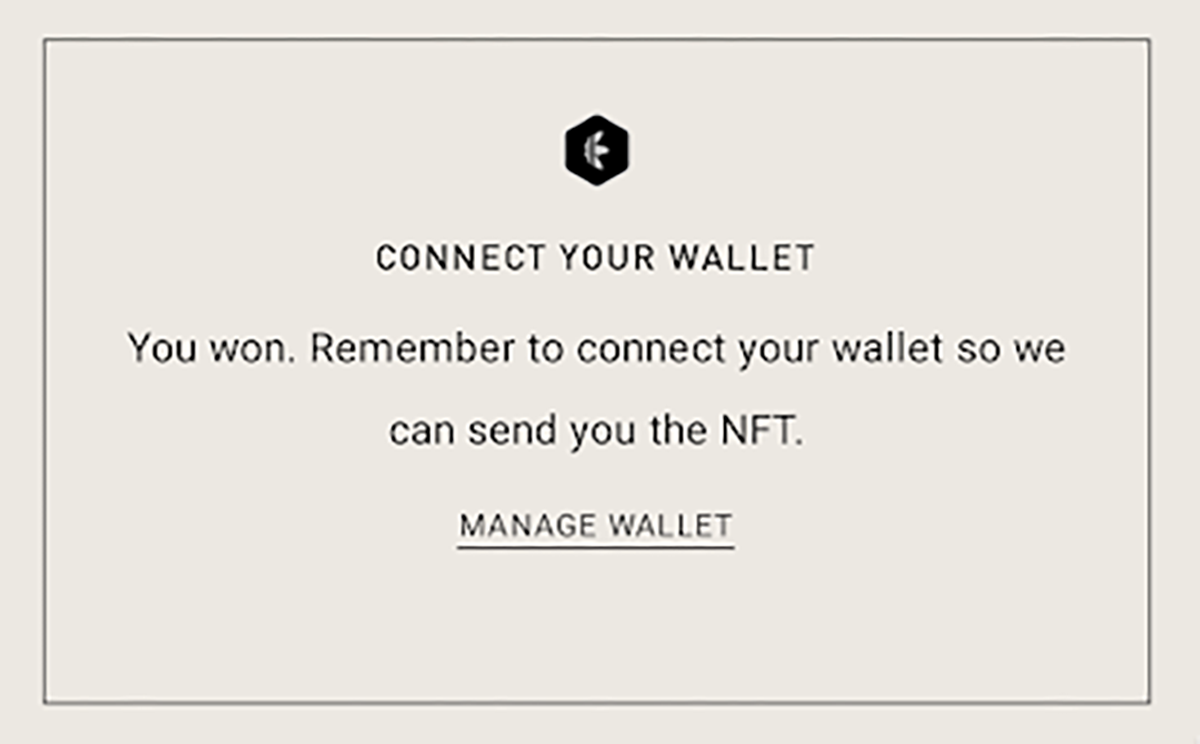

Important Takeaways from the Problematic Moncler x adidas Originals Drop
While many readers might be quick to bash adidas or NFT technology after reading this tale of woe, Blockchain Journal takes a very different view after stumbling through this particular end-to-end user experience. There is no question in our minds that, prior to implementation, a significant amount of professionally administered end-user testing — the sort of testing that’s routine for software leaders like Microsoft, Google, and Apple — would have revealed most if not all of the obstacles. adidas, like other consumer giants, is not a software company. At least not yet. Thanks to the natural forces of competition, it will have no choice but to behave more like one as it continues to offer more customer-facing technology.
However, we are baffled by the various enterprise-grade NFT programs that unjustifiably fracture their user experiences across multiple platforms like Discord and X. All companies rely on multiple technology channels as entry points to their brand experiences. But, just because those different channels must be supported for the customers who prefer to use them as brand entry points doesn’t also mean that users should be needlessly shuffled between those channels to complete their customer journeys. Especially when those channels are hardly suited to the task at hand (user documentation, threaded support discussions, etc.).
More importantly, adidas is in completely uncharted territory. While it remains unclear to Blockchain Journal where the overall responsibility for the Moncler collaboration lies (with the adidas Originals brand or with the company’s Three Stripes Web3 studio?), adidas as a company is not only playing with blockchain to win (and willing to get dangerously close to the third rail along the way), it is giving other global brands a masterclass on how to push the blockchain state-of-state to the point of failure in the name of longer-term success. The reason that most end-to-end user blockchain customer experiences are the brittle patchwork quilts that they are is because the individual parts of those patchworks cannot be improved until an organization like adidas comes along and pushes them to the point of breakage. While we remain disappointed in the experience we encountered, we applaud adidas for putting the pedal to the floor and driving that experience to the brink of failure.
Finally, an important element of this test that was not lost on us was the attempted marriage of adidas’ existing CONFIRMED app with its NFT-based customer engagement program. As many other enterprises move forward with their own NFT-based customer engagement programs (and many are, according to Blockchain Journal’s research), they will eventually have to figure out when and how to align those efforts to programs and technologies that are already in place. For example, sooner or later, Starbucks will have to decide how its Odyssey NFT project should be more tightly woven into its Rewards program (or whether to cancel it altogether). Today, other than the customer identity management system they share, the two run almost independently of one another.
By tying its blockchain customer experience into its CONFIRMED app, adidas has taken an important step toward a comprehensive phygital strategy that aligns its existing physical drop strategy to its evolving digital (NFT) drop strategy. Through its SNKRS mobile app, adidas’ biggest competitor Nike did nearly the same thing one week later. It doesn’t surprise us that two archrivals are running neck and neck in their race to be the better blockchain-driven sports fashion brand.











